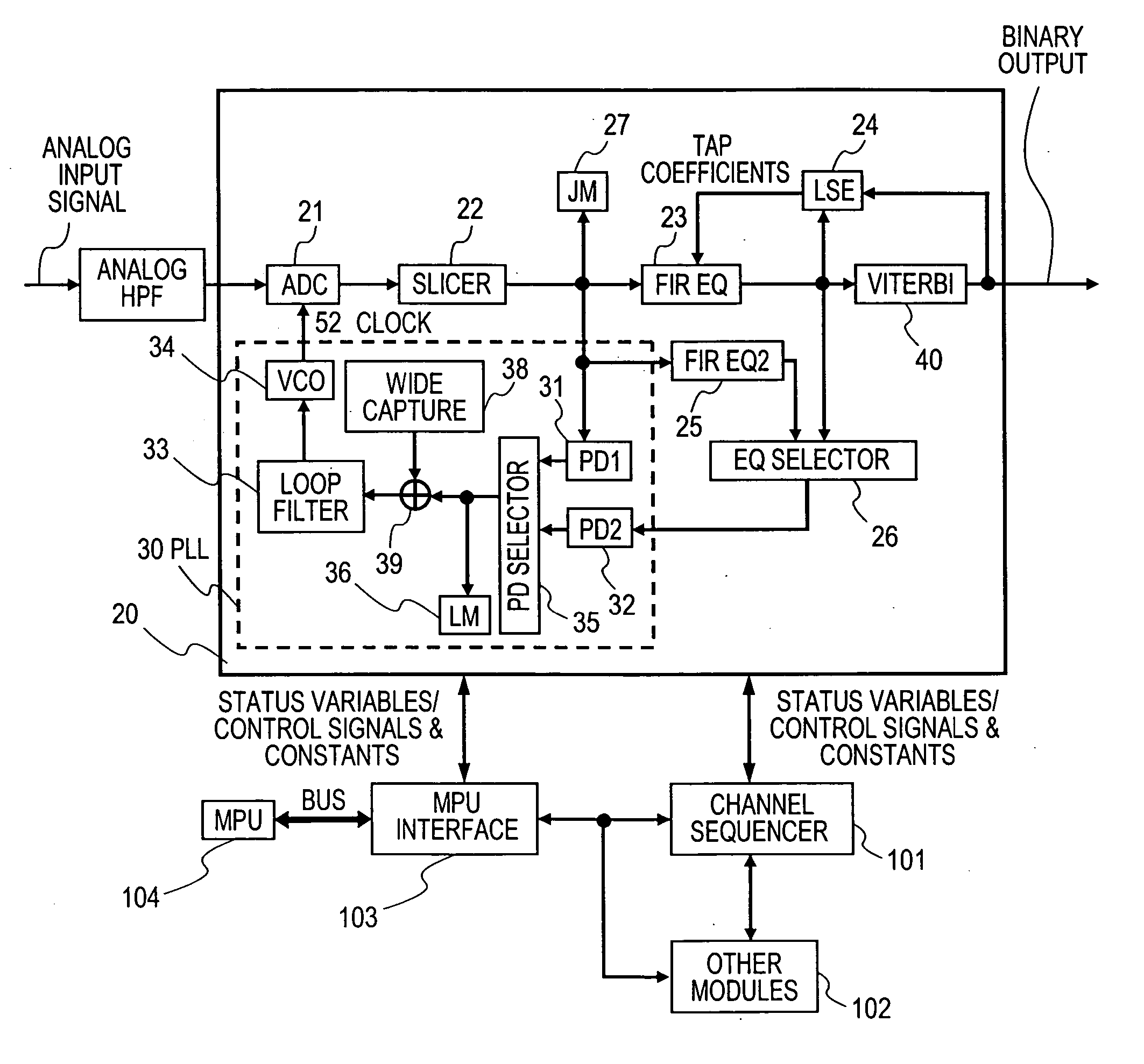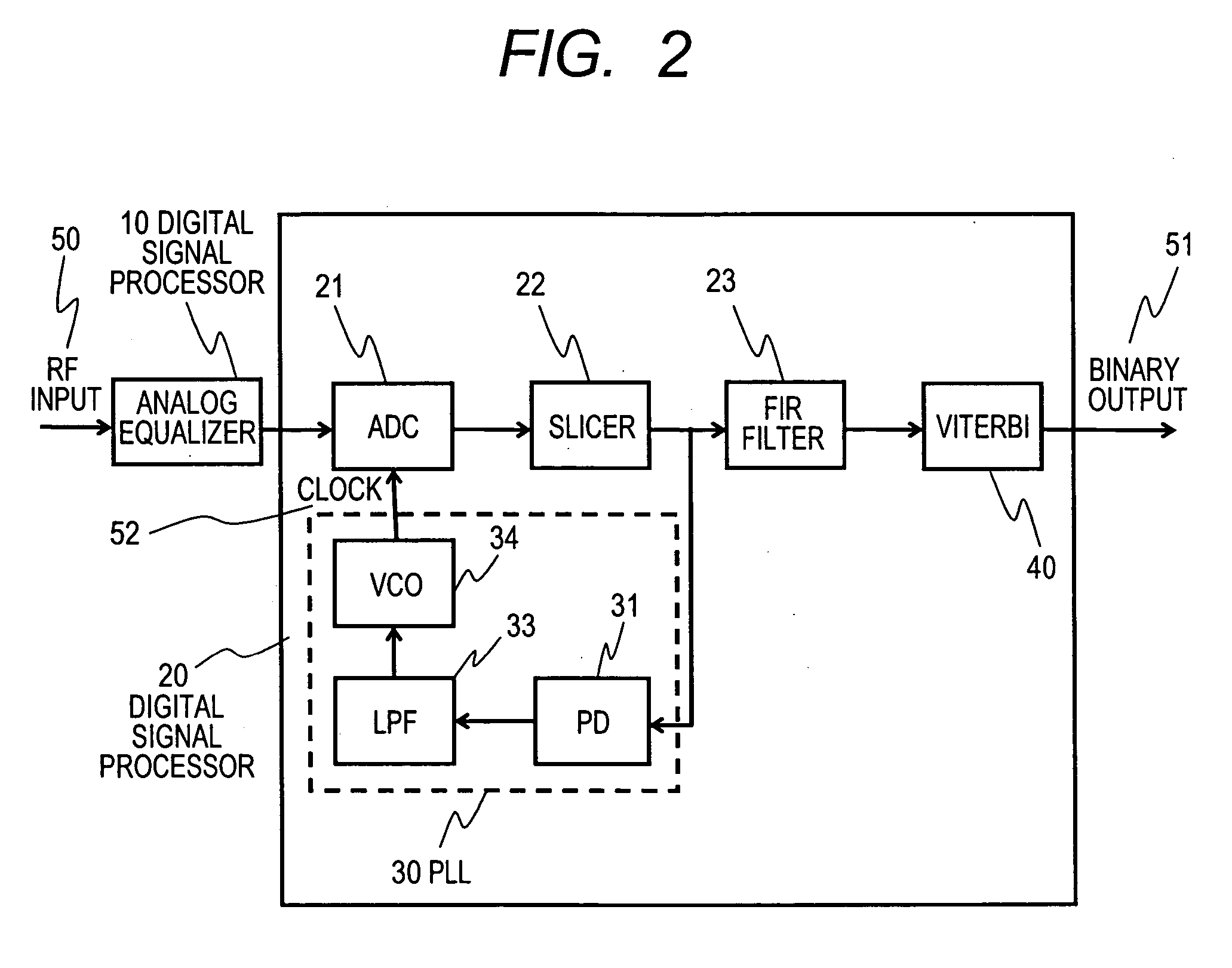Information read device and read signal processing circuit
a signal processing circuit and information read technology, applied in the direction of digital signal error detection/correction, amplitude demodulation, pulse technique, etc., can solve the problems of phase detector used in a pll being affected by noise in the input signal, increasing error rate, and increasing frequency fluctuation in the read clock. , to achieve the effect of suppressing noise, improving snr (signal-to-noise ratio), and increasing error ra
- Summary
- Abstract
- Description
- Claims
- Application Information
AI Technical Summary
Benefits of technology
Problems solved by technology
Method used
Image
Examples
first embodiment
[0037]FIG. 1 is a drawing showing the structure of the decoder circuit for the read signals of the present invention. After AGC and equalization processing by the analog equalizer, the RF signal detected by the optical head not shown in the drawing is input to a digital signal processor 20. After the input RF signals are changed to digital signal per each clock by the AD converter 21, these signals are DC compensated in a slicer 22, digitally processed in the FIR equalizer 23, binarized by a Viterbi decoder 40, and extracted as a binarized output 51. The Viterbi decoder 40 compares the read signal with the target signal generated from the convolution of the PR class and the bit stream, and selects and binarizes a bit stream with a minimal error (difference). The LSE (least square error) controller 24 implements processing for adapting to the tap coefficient of the FIR equalizer described above. The PLL (Phase Locked Loop) circuit 30 that generates a clock signal 52 includes a two ph...
second embodiment
[0042] Various sequences (procedures) are defined in the channel sequencer. These sequences are executed when there is a request from the MPU based on firmware instructions or by taking advantage of different types of interrupt requests issued by a mechanism monitoring state variables of different types held internally in the channel sequencer. These sequences are defined in the following embodiments. A priority level is assigned to each interrupt, and for example, when an interrupt with a high level of priority has been issued during processing for a low priority interrupt, then the on-going processing is halted and the processing for the high priority interrupt is performed first. The priority level for the interrupt can be changed as needed.
[0043] During phase detection utilizing the output of the FIR equalizer or the short FIR equalizer 25, the procedure shown in FIG. 5 is for a mode utilized exclusively when the quality of the read signal that was input is within the range spe...
third embodiment
(Maintaining the PLL Lock)
[0047] A sequence for monitoring the state after completion of PLL pull-in and maintaining the lock is shown in FIG. 6. This sequence is executed if the PLL is unlocked so the channel sequencer must monitor the output of the lock monitor. The process for monitoring the lock monitor output is actually performed by the channel sequencer as previously described, and the expressions contained in this sequence are shown in FIG. 6. These type of expressions are for the purpose of clarifying that the observation variables for the sequence are the lock monitor. These same expressions are used even in flowcharts in other embodiments from hereon for describing the sequence.
[0048] When the PLL pull-in sequence is complete (PLL is in locked state), the PLL shifts to a mode to maintain the lock state. In other words, the sequence shown in FIG. 6 for the pull-in mode that was disabled in pull-in mode is now enabled. As shown in FIG. 6, the lock monitor output is monit...
PUM
| Property | Measurement | Unit |
|---|---|---|
| phase error | aaaaa | aaaaa |
| size | aaaaa | aaaaa |
| lengths | aaaaa | aaaaa |
Abstract
Description
Claims
Application Information
 Login to View More
Login to View More - R&D
- Intellectual Property
- Life Sciences
- Materials
- Tech Scout
- Unparalleled Data Quality
- Higher Quality Content
- 60% Fewer Hallucinations
Browse by: Latest US Patents, China's latest patents, Technical Efficacy Thesaurus, Application Domain, Technology Topic, Popular Technical Reports.
© 2025 PatSnap. All rights reserved.Legal|Privacy policy|Modern Slavery Act Transparency Statement|Sitemap|About US| Contact US: help@patsnap.com



